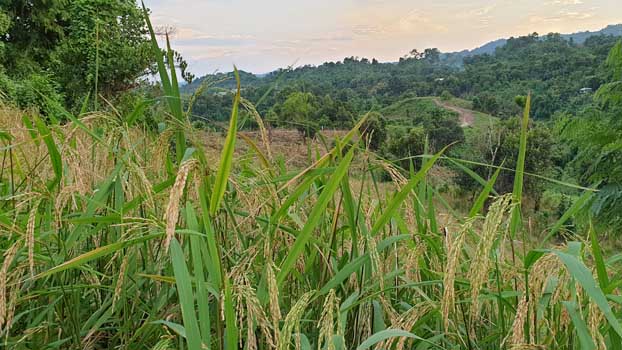Bumper yield brings smile to Jhum farmers in CHT

Bumper harvest in almost all the ‘Jum Farms’ in the Chittagong Hill Tracts (CHT) this year, has brought smiles for the traditional ‘Jum farmers’.
Like previous years, Jum (shifting cultivation) was cultivated in vast areas in three hill districts of CHT---Rangamati, Bandarban and Khagrachhari, this year.
Meanwhile, the farmers almost finished harvesting of paddy in their Jum fields and only the other crops like cotton (Curpas), sesame, millet, barley, sweet pumpkin, pumpkin, green chili and ripe chili remained un-harvested.
The farmers are very happy in this time as they got expected outcome from their Jum farms due to favourable climate and weather and adequate and timely rainfall occurred. They already held “Harvest Festival” in each and every houses of the Jum cultivators. Harvest Festival (Dhan Faang) meant starting of harvesting ripe paddy from the fields and arranging a ‘Feast (luncheon)’ with newly harvested scented rice and feed the guests (neighbours) by any of the owner of any Jum farm in a specific area.
For achieving targeted output, there was a reason of cultivation of a new hybrid varieties paddy seeds in the Jum farms in this year. Department of Agriculture Extension (DAE) encouraged the farmers to cultivate new variety to get good yield.
So, the farmers sowed BIRRI Dhan 48, 82 and 85 and Bina 17 and 19 along with local traditional different varieties in their Jum.
“Jum farmers had been incurring losses and not getting expected yield over the last six years from the fiscal year of 2010-2011 to 2014-2015 from their farms. The production was sharply fallen during that particular periods in the Jum farms and the farmers inclined into cultivation of other crops like ginger, turmeric, arum, banana and fruit orchards,” said Sub-assistant agriculture officer Anisur Rahman at additional director office of DAE, Rangamati.
A total of 17780 hectors of land have been brought under ‘Jum’ cultivation in CHT this year. Of which 9020 hectors in Bandarban, 6510 in Rangamati and 2250 hectors in Khagrachhari. Per hector yield in the current year is 2 metric tons (MT) whereas it was 1.75 MT in the last two year, sources from additional director office of DAE.
In last year, total cultivated land was 17107 hectors.
Basically, Jum (slash and burn) is prepared by cutting jungle of a particular area from the first week of Bengali month of Chaitra. After finishing of cutting jungle the cultivators wait for whole the month for drying up the cut jungle and burn it down. Later they burnt down of Jum fields at the end of Chaitra. Then they clear the chips of trees, bamboo and weeds for sowing paddy seeds.
Then they started sowing paddy seeds along with others crops seeds like cotton, sesame, barley, sweet pumpkin, chili, maize, aubergine, cumcumber and bean in their Jum farms from the Bengali month of Boishakh.
They toil hard thorough out around six months from Boishakh to Bhadra through nourishing and clearing their respective Jum field. At the end of the Bhadra, they start harvesting of crops.
More than hundred types of different scented and aromatic local varieties paddy are cultivate in the Jum farms. Of them, Kabarak, Rengui, Chhoto Rengui, Amei, Bhuppoi, Kamarang, Pattaigi, Gelong, Sonali, Modhumaloti, Rangi, Merung, Charui, Binni etc. are remarkable and most favourite.
Almost all the ethnic communities--Chakma, Marma, Tanchangya, Tripura, Pankhua, Bawm, Lusai, Khiyang, Mro, Khumi and Chak have been cultivating ‘Jum’ since the time immemorial in the CHT region.
“I got expected outcome in this year from my Jum land. I hope I could feed my family around the next eight months of with this paddy. In the previous year I got little yield,” said Ramlai Pankhua, a farmer of Ruma uapzila in Bandarban.
Dhana Kumar Chakma, a farmer of Borohorina union under Barkal upazila in Rangamati, said he is happy with the paddy he got from his two acres of Jum farm.
Nilamoy Chakma, chairman of Borohorina union parishad, told this correspondent that yield in almost all Jum farms in his union is good this year.
Deputy Director of DAE, Paban Kumar Chakma, said as we encouraged Jum farmers to cultivate few new hybrid variety that’s why total yield in the Jum farms is good this year. On the basis of experiment, we gave them hybrid variety for the first time, and let us see their reactions about it.


